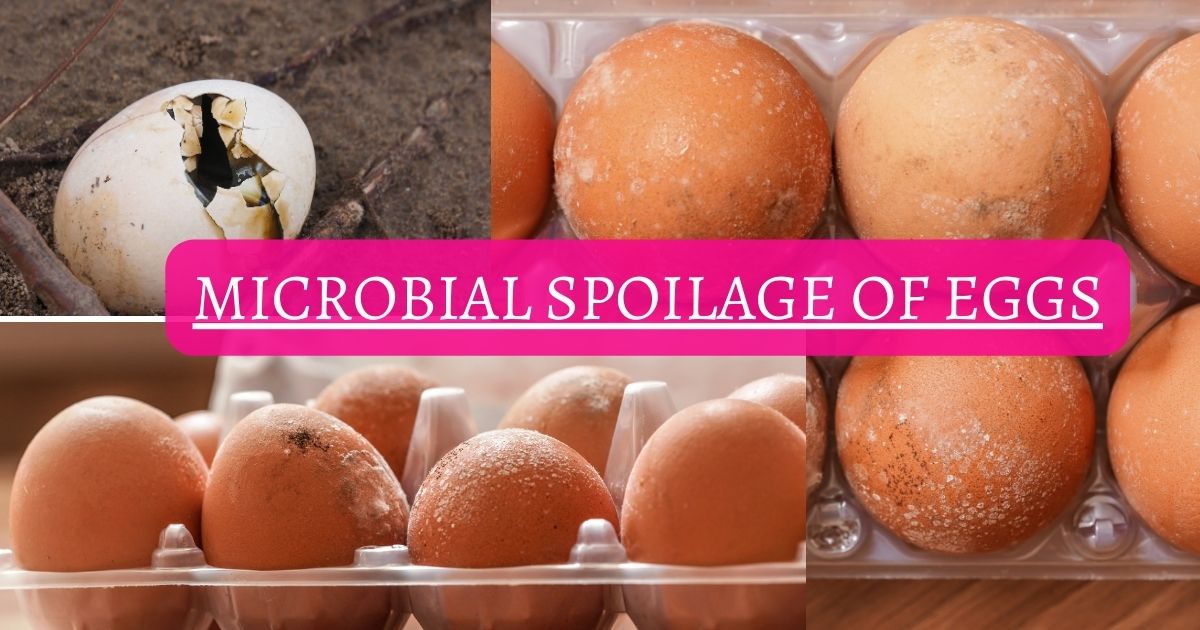MICROBIAL SPOILAGE OF EGGS
It was widely believed in the nineteenth century that the contents of fresh eggs were always sterile. Studies conducted afterwards revealed that microorganisms can gain entry into the egg congenitally. However, most of the contaminants of eggs are of extra genital origin and come in contact with egg shell at oviposition from the dust, soil and faecal matter adhered to the nesting material. Since the cuticle and pores of the eggshell are moist at this stage, the possibility of invasion of the shell by some contaminants through a few pores cannot be ruled out. The microorganisms on the shell surface usually belong to a mixed group, but those causing the spoilage of egg (generally called rot) are gram-negative in nature, which have very simple nutritional requirements.
The microorganisms have to pass through a series of in-built physico-chemical barriers in the egg-the shell, the shell membranes, the albumen before reaching the yolk where they could easily multiply causing rot. The mechanism of microbial spoilage can, thus, be divided into three serial steps:
- Penetration of microorganisms through the eggshell and shell membranes.
- Colonisation of microorganisms on the shell membrane.
- Overpowering of the antibacterial factors present in the albumen.
Penetration of Microorganisms through the Egg Shell and Shell Membranes
Eggshell acquires a diverse microflora at the time of oviposition. Under normal conditions of handling and storage, the shell gets dried soon and most of these microorganisms fail to survive. An eggshell contains more than 17000 pores. However, only ten to twelve pores allow the microorganisms to pass through. The microorganisms either succeed when the egg contents contract on cooling or gain entry due to capillary action through pore canals when the shell surface is moist. The role of microorganisms remains passive in both situations. It is due to capillary action that the incidence of rotting is comparatively high in washed eggs that have been subjected to dry abrasion. The cuticular plugs on the pore canals are opened during the process of abrasion of eggs.
After gaining entry through the shell pores, microorganisms come across shell membranes. These membranes act as bacterial filters and offer maximum resistance to the offending organisms, which have succeeded in penetrating the shell. Some researchers believe that membrane lysozyme also has a limited role.
Mold may also cause rot in eggs under humid storage conditions. In such case shell is generally covered with mycelium (whisker) and hyphae penetrate the pores to reach shell membranes.
Colonisation of Microorganisms on the Shell Membrane
Once the microorganisms have access to the shell membrane, they are able to multiply and form colonies. However, the colonization is not instant. In the early stages, there is preferential selection of gram-negative organisms having low iron requirement from the initial population dominated by gram-positive organisms, which have high iron requirement. Thus initially there is a decline in the microbial numbers. In the later stages, multiplication of organisms takes place at a faster rate because by this time albumen becomes heavily infected. The pH of egg contents moves towards neutrality and the yolk comes in contact with the inner shell membrane.
Overpowering the Antibacterial Factors Present in the Albumen
Egg white or albumen provides an unfavorable medium for microbial growth because of the defensive role played by many of its component proteins, which have been listed under the composition of albumen. The role played by lysozyme and conalbumen is particularly important. Lysozyme of albumen causes lysis of mucopeptide-rich cell wall of gram-positive organisms. This enzyme does not affect the complex cell wall of gram-negative bacteria having a coating of lipoprotein and lipopolysaccharide over mucopeptide.
Conalbumen, which is uniformly distributed and constitutes more than 10% of albumen chelates iron and makes it unavailable to the bacteria. Conalbumen is the principal anti-microbial factor present in the egg and its inhibitory action is more on gram positive as compared to gram-negative organisms. This inhibition definitely delays the spoilage of eggs to some extent. However, as yolk contents migrate into albumen or get mixed, multiplication of organisms is very fast which results in the rotting of eggs. Some general type of rots may be summarised as follows:

Besides rots, eggs may develop various types of off odour due to bacteria without any apparent signs of spoilage. These off odours may be musty or earthy (Achromobacter sp.), hay like {Enterobacter sp.), fish (E. coli) or that of cabbage water (Pseudomonas sp.}.
Defects in albumen and yolk

Sampling method for egg and egg products (AOAC, 1975)
- Liquid Egg: Thoroughly mix liquid egg contents in a container with a sterile sample tube or dipper and transfer about 400 ml to a sterile sample container. Keep samples at below 5°C but avoid freezing. Observe and record odor of each container, sampled as normal, abnormal, reject or musty.
- Frozen Egg: Remove the top layer of the egg with a sterilized hatchet or chisel. Drill three cores midway between the center and periphery and third cores near the edge of the container. Transfer drillings from the container to the sample container with a sterile spoon. Refrigerate samples with solid Co2 or other suitable refrigerant if analysis is to be delayed.
- Dried Egg: For small packages take the entire parcel for a sample. For boxes and barrels remove the top layer with a sterile spoon and with a sterile stirrer, remove three cores as in above. Aseptically transfer the core to the sample container with a sterile spoon or other suitable instrument. Store samples under refrigeration.
